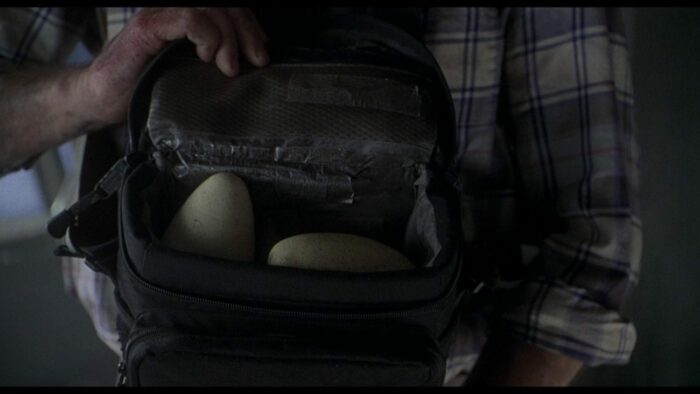Jurassic Park III is often viewed as a sort of black sheep of the family when it comes to the iconic franchise of Jurassic Park. However, as we celebrate its 20th-anniversary it is my belief that Jurassic Park III is a misunderstood picture, one that in fact took the series back to the roots of what Jurassic Park was meant to be. It does not on the surface fit into the story of InGen and the destructive power of good intentions that its owners held. It’s a very small scale story, with personal stakes, is by far the shortest installment of the series, clocking in at a very brisk 93 minutes, and has the lowest Rotten Tomatoes score of the franchise.
The picture was directed by Joe Johnston and written by Peter Buchman, Alexander Payne and Jim Taylor. It brought back Sam Neill and Laura Dern as well as new characters played by William H. Macy, Alessandro Nivola, and Téa Leoni.
Jurassic Park III made the rather drastic choice to make things self-contained and simple. At the very beginning Alan Grant makes it clear when he is asked that he does not want to talk about the events of Jurassic Park or the San Diago incident. The story revolves around Dr. Alan Grant and his assistant Billy being hired to fly over Isla Sorna with a rich married couple and give them a guided tour of the island. Things go south when the couple land the plane and Alan discovers they are not rich and are simply on a rescue mission to find their son who has gone missing somewhere on the island. As they delve deeper into the island they will discover dangerous predators and secrets InGen never revealed.
There are three aspects to Jurassic Park III I want to touch on that I believe elevate the picture, and show that it brought the franchise back to its roots.

Good Intentions
A theme that has run through the series has been that good intention can and often does lead to catastrophe. In Jurassic World, we learn that Simon Masrani was entrusted John Hammond’s dream of Jurassic Park and wanted to make Hammond’s dream come true. However, the need to satisfy investors led to the park falling apart and dozens of deaths, as Masrani fell into the same hubris that Hammond did. Hammond wanted to bring nature to life and teach kids and adults about the world around them, but his hubris led to the downfall of the first park. In Jurassic World 2, we see that Eli Mills is selling Dinosaurs to keep the Lockwood Foundation afloat, viewing the creatures as property that could be controlled for the greater good.
In Jurassic Park III we once again meet Alan Grant in need of funding for his dig sites. His friend and partner Billy is a young grad student who believes in Grant’s work and wants to see their digs become a success. After Grant, Billy, and the others crash on the island, they run across a nesting ground for raptors, filled with unhatched eggs. Unknown to Grant, Billy steals several of the eggs. As they make their way through the island they are hunted by the raptor pack, and its at this time Grant finds the eggs in Billy’s backpack. Billy tries to explain that he only took them so he could sell the eggs and then use the money to fund the dig sites. A horrified Grant then exclaims, “You’re no better than the people who built this place!”
Billy is a great example of the people and ideas that populate the Jurrasic Park series—hubris and good intentions. Billy is not a bad person. He is young and idealistic. He believes in the work that Alan Grant is doing as a paleontologist—work that is getting harder to fund due to the events at Jurrasic Park. Billy is Grant’s partner and student. Grant believes that the real study of dinosaurs is in the field of paleontology, and Billy tries to help him and further their goal of educating people and making discoveries by stealing the eggs.
However, by him stealing the eggs Billy fell into the same thinking as those who built Jurassic Park. He felt he could cut corners to fund education and that he was smarter than nature and the raptors.
The idea that good intentions were what led to all the chaos in the films got somewhat lost in the tale of corporate greed in The Lost World. However, Jurassic Park III drives home the idea that there really were no villains at the start of Jurassic Park. It was simply individuals who were in over their heads and who allowed their good intentions to make them cut corners and think they had control over something uncontrollable.
Fear and Helplessness
Another aspect that Jurassic Park III brought back to the table was fear, weakness, and absolute powerlessness in the face of the creatures of the Jurassic age. The setup for the first picture in the series was that man was out of his depth with dinosaurs and was not ready or able to deal with them or live side by side. We see Malcolm and Muldoon lecture Hammond about how his arrogance about his ability to deal with the creatures would be his undoing; that he felt his technology was enough to control them.
We of course see they were right when the park falls apart. Jurassic Park showed that even with technology humans were helpless. Alan, even with a gun, was unable to stop the raptors and was only saved when the T-Rex came and fought them off. The park’s technology was swatted aside like a toy when the T-Rex escaped from its paddock, and the only thing that saved our heroes was their intelligence and logical thinking.
This idea was somewhat lost in The Lost World as we saw powerful weapons and hunters take on the dinosaurs and full-on tactical teams and military gear in Jurassic World and Jurassic World 2. We see less of humans as the “prey” and more of them as the predator, as the franchise went on.

In Jurassic Park III, the idea of humans as the prey returns. Alan Grant, Billy, and the others are totally powerless in Jurassic Park III—they have no weapons, no cars, no helicopters, and seemingly no way off the island. The family who hired Grant, like Hammond, thought they were prepared. They brought mercs, guns, and tech, only for the dinosaurs to demolish it all within minutes of landing, and killing all the mercs with almost no injuries to the dinos themselves.
We see them have to be creative to distract and combat the menace of the Spinosaurus as it tracks and hunts them. In one memorable scene as we see the group hear the ringing of the missing sat phone (it was eaten by the Spinosaurus), we see them turn to see the dinosaur standing and staring at them with a cold gaze. It’s an utterly terrifying moment that hammers home just how powerless these people really are. All they have is their wits and brains to try and survive as best they can. In the end, they defeat the Spinosaurus using distraction and strategy to escape, and they outwit the raptors by using a 3D model of a raptor skull to talk to them. This brings a huge amount of tension and brings the film full circle back to what made the first movie so great.
Intelligent Dinosaurs
The raptors that populate Isle Sorna in Jurassic Park III are the same vicious creatures they were in the previous two installments, but they are crafted to be more developed characters than before. In fact, a large amount of raptor lore in the Jurassic World franchise comes from Jurassic Park III. Gone are raptors as only killers (as seen in The Lost World), and in their place, we see them as very intelligent, as parents, guardians, and even dare I say it, as showing mercy?
We are introduced to the raptor language and Alan Grant even gets a chance to “talk” with them via a 3D printed replica. We see that raptors don’t just kill for the fun of it and that they will defend and help each other when they are in need. This idea is revisited in Jurassic World when Owen is shown as the “Alpha” raptor and the others obey and help him when he is in danger. Jurrasic Park showed the raptors as killers, but it also showcased them as very smart and problem-solving, opening doors, distracting Muldoon, and testing the fences. In The Lost World, we sadly only see them as mindless killers, hunting and taking down humans with little intelligence. In Jurassic Park III, the intelligence of the raptors is brought back to the forefront, and we are introduced to the raptor language and how they communicate. We see one of them get trapped and call out to its family who rescues it. We see them leave Grant and the others alone after they give back the eggs and communicate with them using the raptor skull. It’s nice to see Jurassic Park III roll back a bit to the first picture and showcase the dinosaurs as smart and not just the sum of their teeth.

In the end, Jurassic Park III is far from a perfect picture. It has its flaws. However, at its core, it tried to steer the franchise back to what made the first film so great. Its subtle exploration of the fall of InGen due to good intentions, and showing the living breathing ecosystem that Isle Sorna turned into post The Lost World was exciting and breathtaking! Jurassic Park III created the first “Jurassic World” showing us what a world without humans populated by dinosaurs would look like, and then dropping some fan-favorite characters into the mix to see how they would fare! Overall I think that Jurassic Park III is worth revisiting and perhaps by seeing it through another lens it can be better appreciated for what it tried to achieve.



